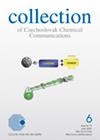DNA bases beyond Watson and Crick
引用次数: 0
Abstract
I am going to discuss the latest results related to the function and distribution of the new nucleobases 5-hydroxymethylcytosine (hmC), 5-formylcytosine (fC), 5-carboxycytosine (caC) and 5-hydroxymethyluracil. These nucleobases seem to play an important role in epigenetic reprogramming of stem cells and some of these bases are also detected at relatively high levels in brain tissues. I will present new synthetic routes that enable preparation of these compounds and of the corresponding phosphoramidites using modern metal organic chemistry. Finally I will discuss how chemistry leads to new insights into the biology of stem cell development processes. In particular mass spectroscopy in combination with the availability of isotopically labeled material allows investigation of the distribution of these novel bases in various tissues and during stem cell development. The recently discovered base formylcytosine for example, is present at relatively high levels in stem cells and its distribution varies during development in a wave like fashion. I am going to describe the distribution of carboxylcytosine in somatic tissues and in stem cells and will provide new quantitative data derived from a detailed mass spectrometric analysis. In order to elucidate the function of the nucleobases we devised a new isotope tracing experiment that enables us to unravel the biochemistry of the bases with high precision and accuracy. I will discuss the synthesis of double [N]-labeled hmC, fC and caC and the preparation of DNA containing these isotopologes. The DNA strands are subsequently added to stem cell nuclear extracts and the formation of the novel nucleobases is followed by high sensitive mass spectrometry.沃森和克里克之外的DNA碱基
我将讨论与新核碱基5-羟甲基胞嘧啶(hmC)、5-甲酰胞嘧啶(fC)、5-羧胞嘧啶(caC)和5-羟甲基尿嘧啶的功能和分布有关的最新结果。这些核碱基似乎在干细胞的表观遗传重编程中起着重要作用,其中一些碱基在脑组织中也被检测到相对较高的水平。我将提出新的合成路线,使这些化合物和相应的磷酰胺的制备使用现代金属有机化学。最后,我将讨论化学如何导致对干细胞发育过程的生物学的新见解。特别是质谱与同位素标记材料的可用性相结合,可以研究这些新碱基在各种组织和干细胞发育过程中的分布。例如,最近发现的基甲酰基胞嘧啶在干细胞中含量相对较高,其分布在发育过程中以波状方式变化。我将描述羧基胞嘧啶在体细胞组织和干细胞中的分布,并将提供从详细的质谱分析中获得的新的定量数据。为了阐明核碱基的功能,我们设计了一种新的同位素示踪实验,使我们能够高精度和准确地揭示碱基的生物化学。我将讨论双[N]标记的hmC、fC和caC的合成以及含有这些同位素的DNA的制备。随后将DNA链添加到干细胞核提取物中,并通过高灵敏度质谱法跟踪新核碱基的形成。
本文章由计算机程序翻译,如有差异,请以英文原文为准。
求助全文
约1分钟内获得全文
求助全文

 求助内容:
求助内容: 应助结果提醒方式:
应助结果提醒方式:


